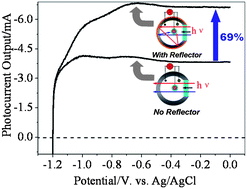Heterogeneous 3-D nanotubular arrays of CdS-TiO2: efficient collections of reflection light for enhanced photoelectric output†
Abstract
This paper describes heterogeneous 3-D nanotubular arrays of CdS-TiO2 fabricated by sensitizing anodized 3-D arrays of TiO2


 Please wait while we load your content...
Please wait while we load your content...